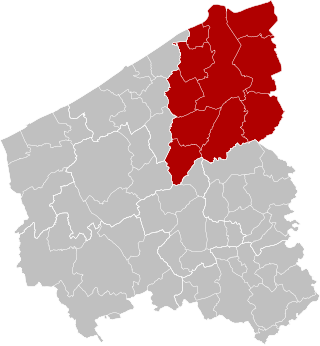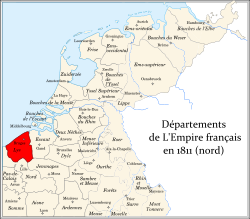
In the administrative divisions of France, the department is one of the three levels of government under the national level, between the administrative regions and the communes. Ninety-six departments are in metropolitan France, with an additional five constituting overseas departments, which are also classified as overseas regions. Departments are further subdivided into 333 arrondissements and 2,054 cantons. These last two levels of government have no political autonomy, instead serving as the administrative basis for the local organisation of police, fire departments as well as, in certain cases, elections.

Léman was a department of the French First Republic and French First Empire. Its name came from the French name of Lake Geneva, Lac Léman. It was formed in 1798, when the Republic of Geneva was annexed by the French Republic. Léman also included districts that were previously part of the departments of Mont-Blanc and Ain. Its territory corresponded with the present Swiss canton of Geneva and parts of the present French departments of Ain and Haute-Savoie.

Escaut was a department of the French First Republic and French First Empire in present-day Belgium and Netherlands. It was named after the river Scheldt, which is called the Escaut in French. It was created on 1 October 1795, when the Austrian Netherlands and the Prince-Bishopric of Liège were officially annexed by the French Republic. Before annexation by France, its territory was part of the County of Flanders and the Dutch Republic (Staats-Vlaanderen).

Deux-Nèthes was a department of the First French Republic and of the First French Empire in present-day Belgium and the Netherlands. It was named after two branches of the river Nete. The southern part of its territory corresponds more or less with the present-day Belgian province of Antwerp. It was created on 1 October 1795, when the Austrian Netherlands were officially annexed by the French Republic. Its territory was the northern part of the former duchy of Brabant. After the annexation of the Kingdom of Holland in 1810, the department was expanded with the western half of the present-day Dutch province of North Brabant, itself historically part of the Duchy of Brabant.

Meuse-Inférieure was a department of the French First Republic and French First Empire in present-day Belgium, Netherlands and Germany. It was named after the river Meuse. Its territory corresponded largely with the present-day provinces of Belgian and Dutch Limburg. It was created on 1 October 1795, when the Austrian Netherlands and the Prince-Bishopric of Liège were officially annexed by the French Republic. Before this annexation, its territory was part of the County of Loon, the Austrian Upper Guelders, the Staats-Oppergelre, the County of Horne, the Abbacy of Thorn, Maastricht and part of the Lands of Overmaas. The lands of the original medieval Duchy of Limburg were associated with the Overmaas lands, lying to their south. The two regions had long been governed together and referred to collectively with both names, but the original Duchy lands were not part of this new entity.

Rhin-et-Moselle was a department of the First French Republic and First French Empire in present-day Germany. It was named after the rivers Rhine and Moselle. It was formed in 1797, when the left bank of the Rhine was annexed by France. Until the French occupation, its territory was divided between the Archbishopric of Cologne, the Archbishopric of Trier, and the Electorate of the Palatinate. Its territory is now part of the German states of Rhineland-Palatinate and North Rhine-Westphalia. Its capital was Koblenz.

Sambre-et-Meuse was a department of the French First Republic and French First Empire in present-day Belgium. It was named after the rivers Sambre and Meuse. It was created on 1 October 1795, when the Austrian Netherlands and the Prince-Bishopric of Liège were officially annexed by the French Republic. Prior to this annexation, the territory included in the department had lain in the County of Namur, the Prince-Bishopric of Liège and the Duchies of Brabant and Luxembourg.

Simplon was a department of the First French Empire. It was named after the Simplon Pass. It was formed in 1810, when the Rhodanic Republic was annexed by France. Its territory corresponded with that of the present-day Swiss canton of Valais.

Ourthe was a department of the French First Republic and French First Empire in present-day Belgium and Germany. It was named after the river Ourthe (Oûte). Its territory corresponded more or less with that of the present-day Belgian province of Liège and a small adjacent region in North Rhine-Westphalia in Germany. It was created on 1 October 1795, when the Austrian Netherlands and the Prince-Bishopric of Liège were officially annexed by the French Republic. Before this annexation, the territory included in the department had lain partly in the Bishopric of Liège, the Abbacy of Stavelot-Malmedy, the Duchies of Limburg and Luxembourg, and the County of Namur.

Dyle was a department of the French First Republic and French First Empire in present-day Belgium. It was named after the river Dyle (Dijle), which flows through the department. Its territory corresponded more or less with that of the Belgian province of Brabant, now divided into Walloon Brabant, Flemish Brabant and the Brussels-Capital Region. It was created on 1 October 1795, when the Austrian Netherlands and the Prince-Bishopric of Liège were officially annexed by the French Republic. Before the annexation, its territory was partly in the Duchy of Brabant, partly in the County of Hainaut, and partly in some smaller territories.

Jemmape was a department of the First French Republic and of the First French Empire in present-day Belgium. It was named after the Battle of Jemappes, fought between the French and the Austrians in 1792 near the village of Jemappes, near Mons. Jemappes was spelled Jemmape, Jemmapes or Jemmappes at the time. Its territory corresponded more or less with that of the Belgian province of Hainaut. It was firstly created on 2 March 1793, and then recreated on 1 October 1795, when the Austrian Netherlands and the Prince-Bishopric of Liège were officially annexed by the French Republic. Before annexation, its territory lay in the County of Hainaut, Tournai and the Tournaisis, the County of Namur (Charleroi) and the Bishopric of Liège (Thuin).

François-Bernard de Chauvelin, marquis de Grosbois, also known as Marquis de Chauvelin, was a French nobleman, diplomat, parliamentarian and liberal reformer.

The Arrondissement of Kortrijk is one of the eight administrative arrondissements in the Province of West Flanders, Belgium.

The Arrondissement of Bruges is one of the eight administrative arrondissements in the Province of West Flanders, Belgium.

The Fifth Battle of Ypres, also called the Advance in Flanders and the Battle of the Peaks of Flanders is an informal name used to identify a series of World War I battles in northern France and southern Belgium (Flanders) from late September to October 1918.

Marie-Étienne Nitot was a French jeweller, the official jeweller to the Emperor Napoleon, and the founder of the House of Chaumet.
André d'Arbelles, was a French journalist and high-ranking official.

The Prefect of Ain is the highest state representative in the department of Ain on the East border of France. Its seat is in Bourg-en-Bresse.

The Departmental Council of Nord is the deliberative assembly of the French department of the Nord, the most populous French department. The headquarters of this decentralized local authority are in Lille.











